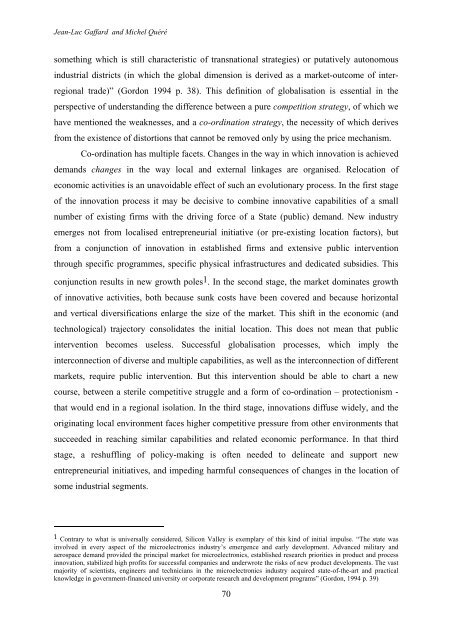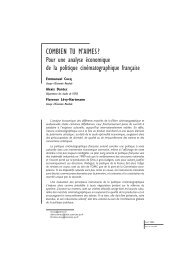N° 2005-09 Juin 2005 Guillaume Daudin* Jean-Luc Gaffard ...
N° 2005-09 Juin 2005 Guillaume Daudin* Jean-Luc Gaffard ...
N° 2005-09 Juin 2005 Guillaume Daudin* Jean-Luc Gaffard ...
Create successful ePaper yourself
Turn your PDF publications into a flip-book with our unique Google optimized e-Paper software.
<strong>Jean</strong>-<strong>Luc</strong> <strong>Gaffard</strong> and Michel Quérésomething which is still characteristic of transnational strategies) or putatively autonomousindustrial districts (in which the global dimension is derived as a market-outcome of interregionaltrade)” (Gordon 1994 p. 38). This definition of globalisation is essential in theperspective of understanding the difference between a pure competition strategy, of which wehave mentioned the weaknesses, and a co-ordination strategy, the necessity of which derivesfrom the existence of distortions that cannot be removed only by using the price mechanism.Co-ordination has multiple facets. Changes in the way in which innovation is achieveddemands changes in the way local and external linkages are organised. Relocation ofeconomic activities is an unavoidable effect of such an evolutionary process. In the first stageof the innovation process it may be decisive to combine innovative capabilities of a smallnumber of existing firms with the driving force of a State (public) demand. New industryemerges not from localised entrepreneurial initiative (or pre-existing location factors), butfrom a conjunction of innovation in established firms and extensive public interventionthrough specific programmes, specific physical infrastructures and dedicated subsidies. Thisconjunction results in new growth poles 1 . In the second stage, the market dominates growthof innovative activities, both because sunk costs have been covered and because horizontaland vertical diversifications enlarge the size of the market. This shift in the economic (andtechnological) trajectory consolidates the initial location. This does not mean that publicintervention becomes useless. Successful globalisation processes, which imply theinterconnection of diverse and multiple capabilities, as well as the interconnection of differentmarkets, require public intervention. But this intervention should be able to chart a newcourse, between a sterile competitive struggle and a form of co-ordination – protectionism -that would end in a regional isolation. In the third stage, innovations diffuse widely, and theoriginating local environment faces higher competitive pressure from other environments thatsucceeded in reaching similar capabilities and related economic performance. In that thirdstage, a reshuffling of policy-making is often needed to delineate and support newentrepreneurial initiatives, and impeding harmful consequences of changes in the location ofsome industrial segments.1 Contrary to what is universally considered, Silicon Valley is exemplary of this kind of initial impulse. “The state wasinvolved in every aspect of the microelectronics industry’s emergence and early development. Advanced military andaerospace demand provided the principal market for microelectronics, established research priorities in product and processinnovation, stabilized high profits for successful companies and underwrote the risks of new product developments. The vastmajority of scientists, engineers and technicians in the microelectronics industry acquired state-of-the-art and practicalknowledge in government-financed university or corporate research and development programs” (Gordon, 1994 p. 39)70








